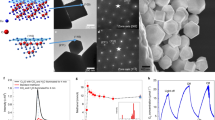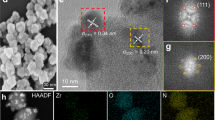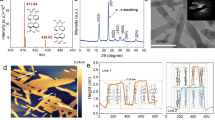Abstract
Solar-driven photocatalytic reactions provide a potential route to sustainable fuels. These processes rely on the effective separation of photogenerated charges, and therefore understanding and exploring the driving force for charge separation is key to improving the photocatalytic performance. Here, using surface photovoltage microscopy, we demonstrate that the photogenerated charges can be separated effectively in a high-symmetry Cu2O photocatalyst particle by asymmetric light irradiation. The holes and electrons are transferred to the illuminated and shadow regions, respectively, of a single photocatalytic particle. Quantitative results show that the intrinsic difference between electron and hole mobilities enables a diffusion-controlled charge separation process, which is stronger than that caused by conventional built-in electric fields (40 mV versus 10 mV). Based on the findings, we assemble spatially separated redox co-catalysts on a single photocatalytic particle and, in doing so, enhance the performance for a model photocatalytic reaction by 300%. These findings highlight the driving force caused by charge mobility differences and the use of asymmetric light illumination for charge separation in photocatalysis.
This is a preview of subscription content, access via your institution
Access options
Access Nature and 54 other Nature Portfolio journals
Get Nature+, our best-value online-access subscription
$29.99 / 30 days
cancel any time
Subscribe to this journal
Receive 12 digital issues and online access to articles
$119.00 per year
only $9.92 per issue
Buy this article
- Purchase on Springer Link
- Instant access to full article PDF
Prices may be subject to local taxes which are calculated during checkout





Similar content being viewed by others
References
Lewis, N. S. Research opportunities to advance solar energy utilization. Science 351, aad1920 (2016).
Chen, S., Takata, T. & Domen, K. Particulate photocatalysts for overall water splitting. Nat. Rev. Mater. 2, 17050 (2017).
Wang, Q. et al. Scalable water splitting on particulate photocatalyst sheets with a solar-to-hydrogen energy conversion efficiency exceeding 1%. Nat. Mater. 15, 611–615 (2016).
Sambur, J. B. et al. Sub-particle reaction and photocurrent mapping to optimize catalyst-modified photoanodes. Nature 530, 77–80 (2016).
Yang, Y. et al. Semiconductor interfacial carrier dynamics via photoinduced electric fields. Science 350, 1061–1065 (2015).
Abdi, F. F. et al. Efficient solar water splitting by enhanced charge separation in a bismuth vanadate–silicon tandem photoelectrode. Nat. Commun. 4, 2195 (2013).
Liu, M. et al. Photocatalytic hydrogen production using twinned nanocrystals and an unanchored NiSx co-catalyst. Nat. Energy 1, 16151 (2016).
Ran, J. R., Zhang, J., Yu, J. G., Jaroniec, M. & Qiao, S. Z. Earth-abundant cocatalysts for semiconductor-based photocatalytic water splitting. Chem. Soc. Rev. 43, 7787–7812 (2014).
Zhang, J., Xu, Q., Feng, Z., Li, M. & Li, C. Importance of the relationship between surface phases and photocatalytic activity of TiO2. Angew. Chem. Int. Ed. 47, 1766–1769 (2008).
Wang, X. et al. Photocatalytic overall water splitting promoted by an alpha-beta phase junction on Ga2O3. Angew. Chem. Int. Ed. 51, 13089–13092 (2012).
Moniz, S. J. A., Shevlin, S. A., Martin, D. J., Guo, Z. X. & Tang, J. W. Visible-light driven heterojunction photocatalysts for water splitting—a critical review. Energy Environ. Sci. 8, 731–759 (2015).
Wang, H. L. et al. Semiconductor heterojunction photocatalysts: design, construction, and photocatalytic performances. Chem. Soc. Rev. 43, 5234–5244 (2014).
Li, R. et al. Spatial separation of photogenerated electrons and holes among {010} and {110} crystal facets of BiVO4. Nat. Commun. 4, 1432 (2013).
Liu, G. et al. Titanium dioxide crystals with tailored facets. Chem. Rev. 114, 9559–9612 (2014).
Baxter, J. B., Richter, C. & Schmuttenmaer, C. A. Ultrafast carrier dynamics in nanostructures for solar fuels. Annu. Rev. Phys. Chem. 65, 423–447 (2014).
Takanabe, K. Solar water splitting using semiconductor photocatalyst powders. Top. Curr. Chem. 371, 73–103 (2016).
Schafer, S., Wang, Z., Zierold, R., Kipp, T. & Mews, A. Laser-induced charge separation in CdSe nanowires. Nano. Lett. 11, 2672–2677 (2011).
Mora-Seró, I., Dittrich, T., Garcia-Belmonte, G. & Bisquert, J. Determination of spatial charge separation of diffusing electrons by transient photovoltage measurements. J. Appl. Phys. 100, 103705 (2006).
Paracchino, A., Laporte, V., Sivula, K., Gratzel, M. & Thimsen, E. Highly active oxide photocathode for photoelectrochemical water reduction. Nat. Mater. 10, 456–461 (2011).
Wick, R. & Tilley, S. D. Photovoltaic and photoelectrochemical solar energy conversion with Cu2O. J. Phys. Chem. C. 119, 26243–26257 (2015).
Hara, M. et al. Cu2O as a photocatalyst for overall water splitting under visible light irradiation. Chem.Commun. 0, 357–358 (1998).
Luo, J. S. et al. Cu2O nanowire photocathodes for efficient and durable solar water splitting. Nano Lett. 16, 1848–1857 (2016).
Tan, C. S., Hsu, S. C., Ke, W. H., Chen, L. J. & Huang, M. H. Facet-dependent electrical conductivity properties of Cu2O crystals. Nano Lett. 15, 2155–2160 (2015).
Li, R., Tao, X., Chen, R., Fan, F. & Li, C. Synergetic effect of dual co-catalysts on the activity of p-type Cu2O crystals with anisotropic facets. Chem. Eur. J. 21, 14337–14341 (2015).
Li, L., Salvador, P. A. & Rohrer, G. S. Photocatalysts with internal electric fields. Nanoscale 6, 24–42 (2014).
Nonnenmacher, M., O’Boyle, M. P. & Wickramasinghe, H. K. Kelvin probe force microscopy. Appl. Phys. Lett. 58, 2921 (1991).
Melitz, W., Shen, J., Kummel, A. C. & Lee, S. Kelvin probe force microscopy and its application. Surf. Sci. Rep. 66, 1–27 (2011).
Chen, R., Zhu, J., An, H., Fan, F. & Li, C. Unravelling charge separation via surface built-in electric fields within single particulate photocatalysts. Faraday Discuss. 198, 473–479 (2017).
Tennyson, E. M. et al. Nanoimaging of open-circuit voltage in photovoltaic devices. Adv. Energy Mater. 5, 1501142 (2015).
Haase, G. Surface photovoltage imaging for the study of local electronic structure at semiconductor surfaces. Int. Rev. Phys. Chem. 19, 247–276 (2000).
Kronik, L. & Shapira, Y. Surface photovoltage phenomena: theory, experiment, and applications. Surf. Sci. Rep. 37, 1–206 (1999).
Zhao, J. & Osterloh, F. E. Photochemical charge separation in nanocrystal photocatalyst films: insights from surface photovoltage spectroscopy. J. Phys. Chem. Lett. 5, 782–786 (2014).
Zhu, J. et al. Direct imaging of highly anisotropic photogenerated charge separations on different facets of a single BiVO4 photocatalyst. Angew. Chem. Int. Ed. 54, 9111–9114 (2015).
Wang, J., Zhao, J. & Osterloh, F. E. Photochemical charge transfer observed in nanoscale hydrogen evolving photocatalysts using surface photovoltage spectroscopy. Energy Environ. Sci. 8, 2970–2976 (2015).
Zhang, Z. & Yates, J. T. Jr Band bending in semiconductors: chemical and physical consequences at surfaces and interfaces. Chem. Rev. 112, 5520–5551 (2012).
McShane, C. M. & Choi, K. S. Photocurrent enhancement of n-type Cu2O electrodes achieved by controlling dendritic branching growth. J. Am. Chem. Soc. 131, 2561–2569 (2009).
Wang, W., Wu, D., Zhang, Q., Wang, L. & Tao, M. pH-dependence of conduction type in cuprous oxide synthesized from solution. J. Appl. Phys. 107, 123717 (2010).
McShane, C. M. & Choi, K. S. Junction studies on electrochemically fabricated p-n Cu2O homojunction solar cells for efficiency enhancement. Phys. Chem. Chem. Phys. 14, 6112–6118 (2012).
Kibria, M. G. et al. Visible light-driven efficient overall water splitting using p-type metal–nitride nanowire arrays. Nat. Commun. 6, 6797 (2015).
Zhang, S. F. et al. On the carrier injection efficiency and thermal property of InGaN/GaN axial nanowire light emitting diodes. IEEE J. Quantum Elect. 50, 483–490 (2014).
Gao, Y. et al. Directly probing charge separation at Interface of TiO2 phase junction. J. Phys. Chem. Lett. 8, 1419–1423 (2017).
Ziegler, D. & Stemmer, A. Force gradient sensitive detection in lift-mode Kelvin probe force microscopy. Nanotechnology 22, 075501 (2011).
Barbet, S. et al. Cross-talk artefacts in Kelvin probe force microscopy imaging: a comprehensive study. J. Appl. Phys. 115, 144313 (2014).
Colchero, J., Gil, A. & Baró, A. M. Resolution enhancement and improved data interpretation in electrostatic force microscopy. Phys. Rev. B 64, 245403 (2001).
Hagfeldt, A. & Gratzel, M. Light-induced redox reactions in nanocrystalline systems. Chem. Rev. 95, 49–68 (1995).
Dember, H. A photoelectrical-motor energy in copper-oxide crystals. Phys. Z. 32, 554–556 (1931).
Goldman, S. R., Kalikstein, K. & Kramer, B. Dember-effect theory. J. Appl. Phys. 49, 2849–2854 (1978).
Chen, M. et al. Light-driven overall water splitting enabled by a photo-Dember effect realized on 3D plasmonic structures. ACS Nano 10, 6693–6701 (2016).
Madelung, O. Semiconductors: Data Handbook (Springer, Berlin, Heidelberg, 2004).
Musselman, K. P., Marin, A., Schmidt-Mende, L. & MacManus-Driscoll, J. L. Incompatible length scales in nanostructured Cu2O solar cells. Adv. Funct. Mater. 22, 2202–2208 (2012).
Siegfried, M. J. & Choi, K. S. Electrochemical crystallization of cuprous oxide with systematic shape evolution. Adv. Mater. 16, 1743–1746 (2004).
Siegfried, M. J. & Choi, K. S. Elucidating the effect of additives on the growth and stability of Cu2O surfaces via shape transformation of pre-grown crystals. J. Am. Chem. Soc. 128, 10356–10357 (2006).
Nian, J.-N., Tsai, C.-C., Lin, P.-C. & Teng, H. Elucidating the conductivity-type transition mechanism of p-type Cu2O films from electrodeposition. J. Electrochem. Soc. 156, H567 (2009).
Sommerhalter, C., Glatzel, T., Matthes, T. W., Jager-Waldau, A. & Lux-Steiner, M. C. Kelvin probe force microscopy in ultra high vacuum using amplitude modulation detection of the electrostatic forces. Appl. Surf. Sci. 157, 263–268 (2000).
Gross, D. et al. Charge separation in Type II tunneling multilayered structures of CdTe and CdSe nanocrystals directly proven by surface photovoltage spectroscopy. J. Am. Chem. Soc. 132, 5981–5983 (2010).
de Jongh, P. E. & Vanmaekelbergh, D. Trap-limited electronic transport in assemblies of nanometer-size TiO2 particles. Phys. Rev. Lett. 77, 3427–3430 (1996).
Yang, Y. et al. Top and bottom surfaces limit carrier lifetime in lead iodide perovskite films. Nat. Energy 2, 16207 (2017).
Huang, M. H., Rej, S. & Chiu, C. Y. Facet-dependent optical properties revealed through investigation of polyhedral Au–Cu2O and bimetallic core–shell nanocrystals. Small 11, 2716–2726 (2015).
Lee, S., Liang, C. W. & Martin, L. W. Synthesis, control, and characterization of surface properties of Cu2O nanostructures. ACS Nano 5, 3736–3743 (2011).
Acknowledgements
This work was supported by the National Natural Science Foundation of China (grant no. 21633015, 21773228), the National Key Basic Research Program of China (973 Program, grant no. 2014CB239403) and the Strategic Priority Research Program and Equipment Development Project of the Chinese Academy of Sciences, grant no. XDB17000000, YJKYYQ20170002.
Author information
Authors and Affiliations
Contributions
R.C. conceived and conducted most of experiments, and analysed data; S.P. conducted the theoretical simulation; H.A. analysed the SPV data and conducted Raman measurements; J.Z. helped in the SPVM measurements; S.Y. helped in the activity measurements; Y.G. analysed KPFM data; F.F. conceived most of the experiments and analysed data. The manuscript was written by R.C. and F.F.; C.L. proposed the project, analysed data and revised the manuscript.
Corresponding authors
Ethics declarations
Competing interests
The authors declare no competing interests.
Additional information
Publisher’s note: Springer Nature remains neutral with regard to jurisdictional claims in published maps and institutional affiliations.
Supplementary information
Supplementary Information
Supplementary Figures 1–20, Supplementary References
Rights and permissions
About this article
Cite this article
Chen, R., Pang, S., An, H. et al. Charge separation via asymmetric illumination in photocatalytic Cu2O particles. Nat Energy 3, 655–663 (2018). https://doi.org/10.1038/s41560-018-0194-0
Received:
Accepted:
Published:
Issue Date:
DOI: https://doi.org/10.1038/s41560-018-0194-0
This article is cited by
-
Stacking textured films on lattice-mismatched transparent conducting oxides via matched Voronoi cell of oxygen sublattice
Nature Materials (2024)
-
Photogenerated outer electric field induced electrophoresis of organic nanocrystals for effective solid-solid photocatalysis
Nature Communications (2024)
-
Liquid metal-embraced photoactive films for artificial photosynthesis
Nature Communications (2024)
-
The reformation of catalyst: From a trial-and-error synthesis to rational design
Nano Research (2024)
-
Silver nanoparticle enhanced metal-organic matrix with interface-engineering for efficient photocatalytic hydrogen evolution
Nature Communications (2023)



